Motorola MicroTAC
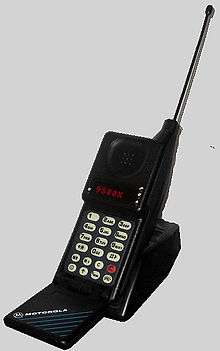
The Motorola MicroTAC was a cellular phone first manufactured as an analog version in 1989. GSM-compatible and TDMA/Dual-Mode versions were introduced in 1994. The MicroTAC introduced an innovative new "flip" design, where the "mouthpiece" folded over the keypad, although the "mouthpiece" was actually located in the base of the phone, along with the ringer. This set the standard and became the model for modern flip phones today. Its predecessor was the much larger Motorola DynaTAC and it was succeeded by the Motorola StarTAC in 1996. "TAC" was an abbreviation of Total Area Coverage in all three models.
Model history
MicroTAC 9800X

The MicroTAC, released by Motorola on April 25, 1989, was the smallest and lightest phone available at the time. Upon its release, it made headlines across the world.[1] The phone was released as the "MicroTAC Pocket Cellular Telephone." The first MicroTACs were known as the Motorola 9800X, a continuation of the numerical name Motorola gave their phones in the 1980s. The MicroTAC was designed to fit into a shirt pocket. These very rare phones featured a black plastic housing and a red 8-character dot-matrix LED display, which was able to show more information than the display of its predecessor, the Motorola DynaTAC 8000X. However, dot-matrix displays of the time were still quite limited by today's standards. The inside of the flip piece had the "Motorola" logo on a diagonal, above thin blue diagonal lines. The badge on the front flip had a raised metallic Motorola logo, and "Micro T.A.C" in small blue letters above the display. The "micro" sized phone measured as long as over 9 inches (23 cm) long when open and weighed in 12.3 ounces (350 g) with the slim battery.[2] The phone incorporated a built-in alpha-numeric phone book as one of the many standard features. A numerically organized menu allowed the user to select options for phone operations. Some of the many options included security codes, two phone number operations, a charge rate and currency calculator, secretarial memory scratchpads, hands-free operation, keypad tones, memory protection, phone number and name storage, as well as cellular system operation options.
In addition to the standard 12-button keypad, the MicroTAC had buttons for Power, Function, Name/Menu, End, Send, Clear, Store, and Recall. The left side of the phone featured two buttons for adjusting the volume up and down. While in alpha mode, the volume buttons toggled between upper-case and lower-case text. The model sold for between U.S. $2,495 and U.S. $3,495, and was produced into the early 1990s before being replaced by newer versions.[3]
Several variants of the 9800X existed, most notably models that featured a 10-character alpha-numeric liquid crystal display (LCD), which had a green backlight. These uncommon variants were made for the Norwegian Storno and Italian SIP networks in the early 1990s. The Storno variants operated on NMT-450 and the SIP models were of the ETACS/RTMS-450 Dual Band. They kept the "MicroTAC" Blue logo on the screen, the same black housing, but had different metallic badges in addition to the LCD.
The original models can be distinguished by their elongated antenna base, white-translucent keys and gray keypad background. Accessories for the phone included car, desktop and overnight travel chargers, installed hands-free car kits, leather cases, and a selection of batteries. The slimmest battery then available was the Slim and Slim Extended (Life), followed by the Standard, XT, and Talk-Pak XT batteries. The Talk-Pak XT and XT used Nickel Metal-Hydride while the others used Nickel Cadmium. A Lithium Ion battery was introduced in 1994.
The early 9800X-era MicroTACs were the only phones to have the microphone and ringer in the mouthpiece. These components were moved to the main phone body in all other models.[3]
Digital Personal Communicator

In 1989, the Digital Personal Communicator, or DPC, was introduced as a lower cost alternative to the 9800X. Light or dark gray in color, the phone featured a green or orange 7-character segment LED display. It closely resembled the 9800x in terms of the keypad design and background and the main body. Early DPCs of the 9800X-era featured the elongated antenna base, round-top side grips, and white-on-gray keypad. Later versions (most likely after 1991) lost the 9800X-specific physical features, but kept the same basic form. Bone white models were also available as special editions to cellular providers in the US. An upscale version of the DPC, known as the MicroTAC 950, or the MicroTAC Alpha in later years featured an 8-character green or orange dot-matrix LED display and the return of the alpha-numeric phonebook. The Alpha phones were "upscale" in that they had more user-programmable options. Also, Alpha phones featured the side grip arrow keys. Soon, an "affordable" DPC 550 came to the market. Almost identical to the Digital Personal Communicator, the DPC 550 featured little with the most basic of operations.
MicroTAC Lite and the Ultra Lite

On August 6, 1991, the MicroTAC Lite was introduced at 7.7 ounces (220 g).[4] The Lite was the lightest phone available, continuing the record of the 9800X. It was basically a slimmer version of the Alpha. Another model, the Lite XL, was released around this time. It had a single-line green LED display and three Memory Location keys added. The Lite was quickly followed by the MicroTAC Ultra Lite. This phone was lighter and had longer battery life. In 1992, a new phone was released, the Ultra-Lite, which weighed 5.9 ounces (170 g), again holding the new record for the lightest phone available.[5] This was due to it being the first phone that utilized NiMH batteries, although replacement batteries were often NiCDs because NiMHs were very expensive. The Ultra Lite was also the first phone with a vibrating ringer.
MicroTAC Classic
In 1991, Motorola released the MicroTAC Classic which resembled the 1989 model, weighing in at 6.9 ounces (200 g). Several changes were carried over from the MicroTAC Lite: the antenna base was shortened, the red LED display was dropped for a 10-character LCD display, and the keys were changed from white to black. The phone was available on the ETACS network. There was a single-band GSM model available in the UK that took credit-card sized SIM cards. The Classic had the same "Motorola" over blue diagonal lines on the inside of the flip, but lost the metallic front badge and blue lettering.
MicroTAC II
In 1991, Motorola released the MicroTAC II. It differed greatly in design from the 9800x, but still retained the basic model form. Changes included a slightly thinner flip, an LCD screen with a green backlight and rounded black keys. The phone ran on the ETACS network.
A year later, Motorola released the MicroTAC II Platinum. It was largely identical, but it reverted to a LED screen with mini-LED status indicators on the bottom of the screen.
MicroTAC Elite
.jpg)
1994 saw the introduction of the MicroTAC Elite and the "International" series, the then smallest and light-weight model available at the time. It weighed in at a mere 3.9 ounces (110 g) with the slim battery.[6] The Elite was a function of NAMPS technology from 1993. The Elite was also produced in a rare MicroTAC Elite VIP (pictured), which had a black housing, gold lettering, and an orange LED display, over the ordinary Elite, which had a gray housing, a green LED display, and white lettering. The Elite series was a feature-packed phone and retailed for around $600. The phone included a first-ever two line display, for a total of 14 dot-matrix characters. There were also separate LED indicator meters for signal strength and battery, as well as a Menu Icon Display. The phone's software offered advanced menu features, and each category, when accessed, was indicated with green icons at the bottom of the display. Categories included Phone Book, Timers, Security, Tone Control, Phone Options, and Answering Machine / Messaging. This was the first mobile phone to have a built-in, recordable answering machine. It was also the first mobile phone to use a Lithium-Ion battery.
International GSM and the Micro DIGITAL
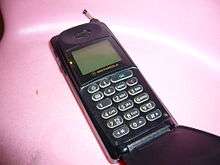

More digital models followed in 1994, mostly in the UK, such as the MicroTAC International 5200, MicroTAC International 8200 and the MicroTAC International Dual Band 8900, which operated on the GSM network. Another model, the International 8700 was fitted as a removable handset in the earliest Jaguar XK8 and Jaguar XKR luxury sports coupes and convertibles up to the end of 1998.[3] Several digital models were produced in the US. One was the short-lived Micro DIGITAL model that operated on the AMPS and TDMA networks, and was similar in appearance to the Alpha model. The MicroTAC Lite was also available for the TDMA network. The other was the MicroTAC Select 6000e, which used SIM cards for the American GSM network. The Select models had large-format backlit LCDs, similar to those found on the MicroTAC 3000e and A725, which operated on CDMA networks.
The success of their analogue microTAC handset blinded Motorola to the implications of the emerging GSM standard. This allowed Nokia to secure a competitive advantage with the Nokia 1011 that was released in 1992, a full two years ahead of the GSM version of the MicroTAC. This left only their Motorola International 3200 "brick" in the GSM market to compete with the Nokia 1011. Many in the industry regard this as the turning point in an industrial cellular landscape that Motorola had historically controlled [7]
MicroTAC 650/650E and decline
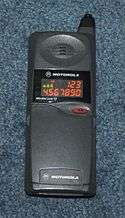
In 1996, the diminutive Motorola StarTAC was released, which provided fierce competition for MicroTAC. The phone received a redesign in 1996, with a more rounded case and thinner flip-lid. Two Memory Location keys were added to the phone. Base models were known as the DPC 650, which kept the 550's display. A more expensive model, the MicroTAC DPC 650E received the StarTAC 3000's 10-character LED display with separate battery and signal meters. It weighed 7.8 ounces (220 g). Like the StarTAC, the MicroTAC 650E ("E" for Enhanced Features) received some feature upgrades, such as selectable ringer styles, but lost the alpha-numeric phonebook. The 650E was available in gray or black. The 650E was one of the better selling models in the US, along with the Elite and DPC 550. The MicroTAC was produced up until 1998, when sales declined with the increasing popularity of the StarTAC. The phone was still relatively commonplace into the early 2000s. However, due to its large size and weight, many owners of the phone upgraded to smaller models like the StarTAC.
CipherTAC
The CipherTAC was a spin-off of the MicroTAC series. It offered unrecoverable, encrypted communication and was purpose-built for the Secretary of State and other officials. It was not made available in mainstream. The fate of these units is currently unknown.
Design-wise, the CipherTAC took after the Elite VIP.
Clone models
The MicroTAC body was also used as the base model for the Motorola TeleTAC and the Flare series. The TeleTAC and Flare phones used the same core body, antenna, screen, keypad, and batteries, but lacked the flip-lid cover. The MicroTAC 650E lost the flip and Memory Location keys and gained arrow keys to become the Profile 300E.
V.I.P. Models
Many MicroTAC models were available with the upscale VIP option. VIP phones were black with gold lettering, had a dark orange dot-matrix LED display (only 9800X models had a true red display) and additional menu features. Lites, Ultra-Lites, Lite IIs, Lite XLs, Elites, and Alphas were all available as VIP phones.
Model list
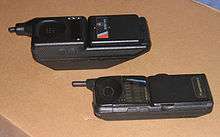
- 1989
- MicroTAC 9800X (AMPS/ETACS/NMT/JTAC)
- Digital Personal Communicator (AMPS/ETACS)
- 1990
- MicroTAC 9800X S.I.P. (ETACS/RTMS-450)
- MicroTAC 950 (AMPS)
- 1991
- MicroTAC Classic (ETACS/NMT/GSM 900)
- MicroTAC Lite (AMPS)
- MicroTAC Lite VIP (AMPS)
- MicroTAC II (ETACS)
- 1992
- MicroTAC II Platinum (ETACS)
- MicroTAC Alpha (AMPS)
- MicroTAC Alpha VIP (AMPS)
- MicroTAC Ultra-Lite (AMPS)
- MicroTAC Ultra-Lite VIP (AMPS)
- 1993
- MicroTAC Lite XL (AMPS)
- MicroTAC Pro (ETACS)
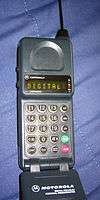
- 1994
- Micro DIGITAL (TDMA/AMPS)
- Micro Digital Lite (TDMA/AMPS)
- MicroTAC Elite (NAMPS)
- MicroTAC Elite VIP (NAMPS)
- MicroTAC Digital Elite (TDMA/NAMPS)
- MicroTAC International 5080 (GSM 900)
- MicroTAC International 5200 (GSM 900)
- MicroTAC International 7200 (GSM 900)
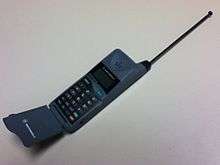
- 1995
- MicroTAC Piper (AMPS)
- DPC 550 (AMPS)
- DPC 650 (AMPS)
- MicroTAC 650 E (AMPS)
- MicroTAC International 7500 (GSM 900)
- MicroTAC International 8200 (GSM 900)
- 1996
- MicroTAC International 8400 (GSM 900)
- MicroTAC International 8700 (GSM 900)
- 1997
- MicroTAC Select 3000e (GSM 1900)
- MicroTAC Select 6000e (GSM 1900)
- MicroTAC 725 (CDMA)
- MicroTAC International 8900 (GSM 900/1800)
- 1998
- MicroTAC 8200 (AMPS)
In popular culture
- Hook (1991) – Peter Banning (Robin Williams) has a black MicroTAC 9800X, which is featured in the first segment of the movie before being thrown out of a window and buried by Granny Wendy's (Maggie Smith) dog, Nana.
- Black Sheep (Feb. 1996) – Steve Dodds (David Spade) has a MicroTAC Elite VIP that cannot seem to find a signal anywhere.
- My Best Friend's Wedding (Jun 1997) – Julianne Potter (Julia Roberts) has a DPC 550 complete with leather case throughout the length of the film.
- Three Kings (1999; 1991 depicted) – Sergeant First Class Troy Barlow (Mark Wahlberg) finds a MicroTAC 550 amongst a pile of DynaTACs (some broken) in an underground bunker. Having trouble with a jobsworth Iraqi operator when he attempts to call on a DynaTAC, he finally manages to calls home on the MicroTAC.[8]
References
- ↑ Motorola Has a Pocket-Size Cellular Phone Los Angeles, April 26, 1989
- ↑ "All About/Cellular Telephones; A Gadget That May Soon Become the Latest Necessity". The New York Times. January 28, 1990.
- 1 2 3 Motorola Analogue MicroTAC RETROBRICK - the home of vintage and rare mobile phones
- ↑ Motorola's new MicroTac lite weighs in at 7.7 oz August 15, 1991
- ↑ Motorola introduces ultra lite 5.9 ounce cellular telephone September 10, 1992
- ↑ Hold your calls - Nokia 2120 and 100, AT and T 3770, Panasonic EB-H40, Oki 1325 and Motorola Ultra Classic II and MicroTAC Elite cellular telephones - Evaluation March 1995
- ↑ "Nokia's first GSM handset (1992)?". Stephen Temple. Retrieved 6 April 2013.
- ↑ Three Kings: Call Home on YouTube
External links
| Wikimedia Commons has media related to Motorola MicroTAC. |
- Motorola
- All About Cellular Telephones
- "Motorola Has a Pocket Sized Cellular Phone" (Paywalled, with excerpts). Los Angeles Times. pqarchiver.com/Tribune Newspaper. 1989-04-26. Retrieved 2013-07-01.
- Motorola's New MicroTAC Lite
- Motorola Introduces Ultra-Lite
- Hold Your Calls